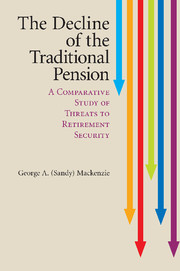Book contents
- Frontmatter
- Contents
- List of Tables
- List of Figures
- List of Boxes
- Acknowledgments
- Introduction
- PART ONE
- 1 The Development of Employer-Provided Pensions
- 2 The Economics of Employer-Provided Pension Plans
- 3 Issues in Funding and Investing
- 4 Current Regulatory Issues
- 5 Public-Sector Employer-Provided Pensions and Recent Innovations in the First Tier
- PART TWO
- Appendix 1 Ten Country Profiles
- Appendix 2 Mathematical Treatments and Derivations
- Glossary
- References
- Index
2 - The Economics of Employer-Provided Pension Plans
Published online by Cambridge University Press: 05 June 2012
- Frontmatter
- Contents
- List of Tables
- List of Figures
- List of Boxes
- Acknowledgments
- Introduction
- PART ONE
- 1 The Development of Employer-Provided Pensions
- 2 The Economics of Employer-Provided Pension Plans
- 3 Issues in Funding and Investing
- 4 Current Regulatory Issues
- 5 Public-Sector Employer-Provided Pensions and Recent Innovations in the First Tier
- PART TWO
- Appendix 1 Ten Country Profiles
- Appendix 2 Mathematical Treatments and Derivations
- Glossary
- References
- Index
Summary
An Overview of the Life-Cycle Model of Saving
The life-cycle model of saving is the foundation of the economics of saving, and hence the starting point of modern pension economics. Its basic premise is that people will plan to spend all of their income in the course of their lifetimes, apart from the income that may be set aside to fund a bequest. As Keynes put it: “Consumption is the end of all economic activity” (Keynes 1973, 107).
Unlike the most basic versions of the consumption function model, which are still found in macroeconomics textbooks, the life-cycle model does not assume that people mindlessly spend a fixed share of any additional income they earn. Instead, people are assumed to want to maintain a fairly constant level of consumption over time. The object of saving is to smooth consumption – that is, to transfer purchasing power from periods when income is typically high to periods when it is low. Saving can fluctuate over the course of a person's working life as his or her earned income rises and falls. However, even if income is completely smooth, saving is still necessary to ensure that consumption can be maintained at adequate levels once a person is no longer earning an income.
The role of saving in providing for retirement can be illustrated by a simple model with two time periods: period one, working life, and period two, postworking life or retirement.
- Type
- Chapter
- Information
- The Decline of the Traditional PensionA Comparative Study of Threats to Retirement Security, pp. 36 - 64Publisher: Cambridge University PressPrint publication year: 2010



